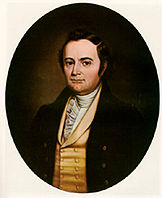United States House of Representatives elections, 1826
|
|
|||||||||||||||||||||||||
|---|---|---|---|---|---|---|---|---|---|---|---|---|---|---|---|---|---|---|---|---|---|---|---|---|---|
|
|||||||||||||||||||||||||
|
All 213 seats to the United States House of Representatives 107 seats were needed for a majority |
|||||||||||||||||||||||||
|
|||||||||||||||||||||||||
|
|||||||||||||||||||||||||
Elections to the United States House of Representatives for the 20th Congress were held at various dates in each state in 1826 and 1827 during John Quincy Adams' term in office.
In these midterm campaigns, the aftershock of the contested 1824 presidential election remained a major issue. The former Democratic-Republican Party had split into two parties, the Jacksonians, supporting Andrew Jackson (which would later become the Democratic Party) and the Adams men or Anti-Jacksonians, supporters of President John Quincy Adams. Adams' supporters would later come to be known as the National Republican Party. The Jacksonians were able to pick up a slim majority in the House by painting an image of the Adams Men as elitist and of the Jacksonians as the party of the common farmer or artisan. This tactic helped them pick up a number of rural seats.
Louis McLane (J) resigned before the start of the 20th Congress, having been elected to the Senate and was replaced in a special election by Kensey Johns, Jr. (A)
Georgia switched to using districts for this election. Two incumbents, James Meriwether and George Cary, did not run for re-election.
...
Wikipedia


